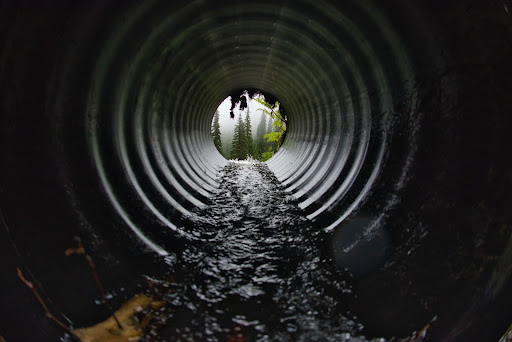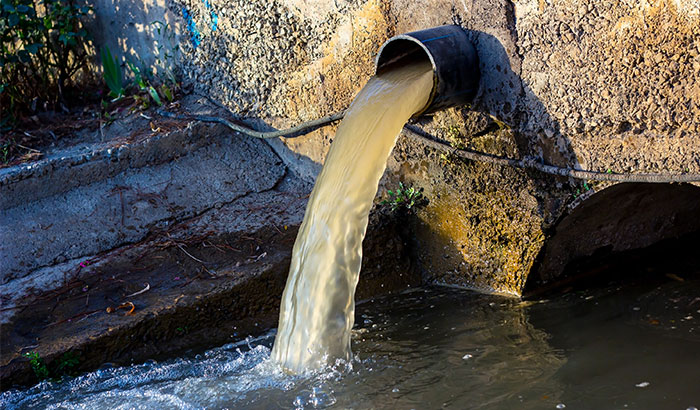Sewage damage can be a major headache for homeowners, leading to costly repairs and potential health hazards.
To help you prevent such issues, here are 30 things that can cause sewage damage, along with tips on how to avoid them:
- Clogged Pipes: Flushing non-biodegradable items like wipes, paper towels, or feminine hygiene products can lead to pipe blockages. These materials do not break down easily and can accumulate, causing clogs.
Encourage household members to only flush toilet paper and waste. Consider providing clear instructions and informative signage near toilets. Additionally, consider placing a waste bin in the bathroom to make proper disposal convenient.
- Tree Roots: Plant trees away from sewer lines to avoid root intrusion. Tree roots are naturally drawn to water sources and can penetrate small cracks or openings in pipes. To prevent root growth towards sewer lines, consult an arborist for guidance on suitable tree species and planting distances from your plumbing system.
If trees are already present, use slow-release root control chemicals or install root barriers to discourage root growth towards the pipes.
- Grease Buildup: Dispose of cooking grease in a separate container, allow it to solidify, and throw it in the trash. Pouring grease down the drain may seem convenient, but it can accumulate inside the pipes, leading to blockages.
To prevent grease buildup, provide clear guidelines to household members about proper grease disposal. Encourage the use of grease traps in commercial kitchens, and ensure these traps are regularly cleaned and maintained.
- Aging Pipelines: Regularly inspect your plumbing system, especially older pipes, for signs of deterioration such as corrosion, cracks, or leaks. Aging pipes are more susceptible to damage, leading to sewage leaks or backups.
Hire a professional plumber to assess the condition of your pipes and replace any worn-out sections promptly. Consider scheduling regular inspections to catch potential issues early.
- Pipe Bellies: During the installation or maintenance of plumbing pipes, ensure they are adequately supported and have no sagging or low points where waste can accumulate. Pipe bellies, or low spots in the piping, impede the proper flow of sewage and increase the risk of backups.
Proper pipe installation involves maintaining a consistent slope to ensure efficient drainage. Consult a licensed plumber to ensure correct pipe installation and to avoid potential problems.
- Flushing Foreign Objects: Educate household members about the importance of only flushing toilet paper and waste. Discourage flushing items like cotton balls, dental floss, or cigarette butts.
These items can accumulate in the pipes and cause blockages. Provide educational materials or signage near toilets to raise awareness about proper flushing practices.
- Structural Damage: Regularly inspect your property for signs of foundation settling or shifting that can damage sewer lines. Foundation issues, such as cracks or uneven settling, can stress the pipes and lead to leaks or breaks.
Consult a foundation specialist if you notice any signs of structural damage, such as cracks in the walls or foundation, uneven floors, or doors that don’t close properly. Addressing foundation issues promptly can help prevent sewage damage.
- Invasive Plants: Avoid planting invasive plant species near sewer lines. Invasive plants have aggressive root systems that can infiltrate pipes and cause blockages or breaks.
Research local guidelines for suitable vegetation near utility lines to prevent root intrusion. Choose non-invasive plant species for landscaping around your property, particularly near sewer lines.
- Extreme Temperatures: In regions with freezing temperatures, protecting your pipes from freezing and potentially bursting is crucial. Insulate pipes properly, especially in unheated areas or near exterior walls. Use pipe insulation sleeves or heat tape and seal any cracks or openings in the walls or foundation that could let in cold air.
Allow faucets to drip slowly during cold snaps to keep water flowing and prevent freezing.
- Heavy Rainfall: Ensure your property has proper drainage systems, including well-maintained gutters, downspouts, and grading. Poor drainage can cause excess rainwater to accumulate around sewer lines, leading to backups.
Regularly clean and unclog gutters and downspouts to ensure efficient water flow. Consider installing rain barrels or French drains to divert water from the foundation and sewer lines.
- Flooding: Install backflow preventers to stop sewage from flowing back into your home during heavy rainfall or flooding. Backflow preventers are valves or devices that prevent reverse flow, protecting your property from sewage backups.
Consult a professional plumber to determine the appropriate type of backflow preventer for your plumbing system and ensure proper installation.
- Faulty Sewer Lines: Regularly inspect and maintain your sewer lines to detect cracks, joint failures, or blockages. Signs of potential sewer line problems include slow drainage, foul odors, or wet spots in the yard.
Address any problems promptly by hiring a professional plumber experienced in sewer line repair. If needed, they can perform video inspections, hydro-jetting to clear blockages, or trenchless repair methods.
- Shifting Soil: Monitor soil movement around your property, especially during construction or landscaping projects. Shifting soil can stress sewer lines and lead to breaks or leaks.
Properly compact soil after excavation or construction work to ensure stable ground conditions. Install retaining walls or erosion control measures to prevent soil movement and protect sewer lines if needed.
- Plumbing System Overload: Be mindful of water usage during peak hours to prevent overwhelming the plumbing system. Avoid running multiple high-demand water appliances simultaneously, such as washing machines and dishwashers.
Distribute water usage throughout the day to avoid excessive wastewater flow that can strain the system and potentially cause backups.
- Poor Ventilation: Proper ventilation is crucial for your plumbing system to maintain optimal pressure and prevent pressure buildup that can lead to backups. Ensure your plumbing system has adequate vent pipes that extend through the roof. These vents allow for the release of sewer gases and maintain proper drainage. Follow local building codes and regulations for venting requirements during new installations or renovations.

- Corroded Pipe Connections: Regularly inspect pipe connections for signs of corrosion, loose fittings, or leaks. Corroded pipe connections can result in sewage leaks, leading to property damage and health hazards.
Tighten or replace connections as necessary, using pipe sealant or Teflon tape for secure fittings. Consider using corrosion-resistant materials for pipe connections, such as brass or stainless steel.
- Sewage Pump Failure: If your property relies on a sewage pump, regular maintenance is crucial to ensure its proper functioning. Schedule periodic inspections and servicing by a professional to test the pump, clean or replace worn-out parts, and address any malfunctions promptly.
Proper maintenance of the sewage pump helps prevent backups and sewage damage.
- Septic Tank Maintenance: If you have a septic system, adhering to regular maintenance schedules is essential to prevent sewage damage. This includes routine septic tank pumping and inspections.
Neglecting septic tank maintenance can lead to backups, system failures, and contamination. Consult a septic professional to determine the appropriate pumping frequency based on the tank size and household usage.
- Construction Debris: Properly dispose of all construction debris, such as cement, sand, or gravel, to prevent it from entering the sewer lines and causing blockages.
Use designated construction waste containers or hire a waste removal service to ensure proper disposal. Implement strict construction site cleanliness practices and provide clear instructions to workers about properly disposing of debris.
- Grease Traps: Install and regularly clean grease traps in commercial kitchens to capture fats, oils, and grease before they enter the sewer system. Grease traps prevent these substances from solidifying and clogging the pipes. Develop a regular cleaning schedule for grease trap maintenance and educate staff on proper disposal practices.
- Illegal Connections: Ensure all plumbing fixtures, drains, and appliances are correctly connected to the appropriate systems and not tied to the sewer lines. Illegal connections, such as sump pumps or roof drains connected to the sewer system, can overwhelm the system and cause sewage backups and contamination.
Check for proper plumbing connections during inspections and address any illegal connections promptly.
- Water Main Breaks: Monitor your municipality’s water infrastructure and promptly report any signs of water main breaks. Water main breaks can cause sewer backups on your property.
Stay informed through local news or water department notifications, and report any abnormalities such as water discoloration or low water pressure. Promptly address any issues related to water main breaks to prevent sewage damage.
- Insufficient Cleanouts: Have adequate cleanouts installed in your plumbing system for easy access during maintenance and repairs. Cleanouts are access points that allow for the efficient removal of clogs and prevent sewage backups.
Consult a plumber for proper cleanout placement based on your plumbing layout. Install cleanouts at critical points, including horizontal pipes, bends, and main sewer lines.
- Lack of Backflow Prevention Devices: Install backflow prevention devices, such as check valves or air gaps, on plumbing fixtures prone to backflow, such as floor drains or laundry sinks.
Backflow prevention devices prevent sewage from flowing backward into your property. Consult a licensed plumber to determine the appropriate backflow prevention devices for specific fixtures and ensure proper installation.
- Soil Erosion: Maintain the landscaping around your property to prevent soil erosion, which can expose and damage sewer lines. Implement erosion control measures such as retaining walls, vegetation, or mulching to stabilize the soil and prevent erosion.
Regularly inspect the soil around sewer lines for signs of erosion, and address any issues promptly to protect the pipes.
- Sump Pump Failure: Regularly inspect and maintain your sump pump to ensure it is in good working condition. Test the pump periodically, clean the pump and pit, and replace worn-out parts.
A functioning sump pump prevents sewage backups during heavy rainfall or when groundwater levels rise. Consider installing a backup power source, such as a battery-powered backup pump, to ensure continuous operation during power outages.
- Overgrown Vegetation: Trim and maintain vegetation around your property, especially near sewer access points such as cleanouts or inspection points. Overgrown plants can obstruct access to these points, making maintenance and repairs difficult.
Regularly trim vegetation, shrubs, and tree branches to ensure clear access to sewer components.
- Damaged Sewer Vents: Check and repair any damaged or blocked sewer vents on your roof. Proper venting allows for the release of sewer gases and prevents pressure buildup in the system.
Ensure vents are free of debris, cracks, or blockages. In colder climates, protect vents from freezing by installing vent guards or insulation caps.
- Improper Sloping: During installation or repairs, ensure proper slope angles for sewer lines to allow for efficient wastewater flow. Incorrect slopes can cause sluggish drainage or backups.
Consult a professional plumber experienced in proper pipe installation to ensure correct slope angles based on local building codes and standards.
- Improper Disposal of Medications: Avoid flushing medications down the toilet or sink as they can contaminate water sources. Follow local guidelines for proper medication disposal, such as using drug take-back programs or designated drop-off locations. Educate household members on the importance of responsible medication disposal to prevent environmental contamination.
By being mindful of these 30 factors and following the detailed tips, you can significantly reduce the risk of sewage damage in your home. Remember that prevention is key, and proactive maintenance is crucial to a healthy and functional sewer system.
Black Diamond Restoration Can Help
Black Diamond Restoration provides 24/7 sewage, water, mold, fire, smoke, and storm damage restoration to the greater Salt Lake and Utah Valley areas. Call us at 801.797.2502 to schedule your service.
toto slot






